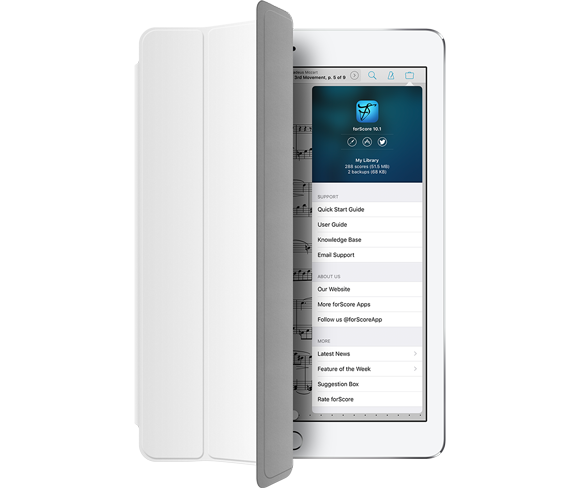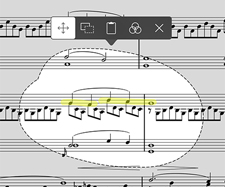September 2, 2016
| Feature of the Week
Last week we began our discussion of the major improvements made to forScore’s Darkroom feature in 10 with the Crop tool (read more about that here if you haven’t had a chance to already). Today we’re looking at another new tool, Enhance.
The Enhance tool is easy to use: tap the magic wand icon in the toolbar at the bottom of Darkroom’s main view to use it for all of the photos in your workspace, or tap an image to show the full-screen preview and use it there to affect only that particular image. In short, it makes your images better.
Behind the scenes, iOS scans your photo and creates a customized set of filters that are designed to give you the best possible results by adjusting brightness, contrast, tone, and more. Then, since we know we’re working with images of printed paper rather than portraits or scenic landscapes, we remove color information and increase the contrast a little more (both of these changes are editable since they’re made using the Adjust tool, which we’ll be discussing next week).
Easy to use, and a little more complicated to explain, the end result is that your images generally look clearer and more like they were made on a flatbed scanner than with a point-and-shoot.

This summer’s release of forScore 10 has been a tremendous success, and we’re extremely grateful for all of the acclaim and positive feedback we’ve received from both customers and the press. After months of hard work it’s incredibly rewarding to finally see the real-world impact of each new feature and improvement. You might even think we’d be headed out for a long vacation.
We’re a restless bunch, though, so of course we immediately jumped right in to begin crafting the first big update to forScore 10, version 10.1, and today we’re giving you a sneak peek at what’s to come. Although we don’t usually spend much time talking about “minor” point releases, make no mistake that 10.1 is going to really take things up a notch.
In fact, thanks to the major foundational improvements we made in forScore 10, we’re going to stick with it for a while and let these point releases serve a much bigger role. Focusing on them will give us more flexibility and let us release interesting features when they’re ready instead of artificially delaying them until the next major update.
So without further ado, you can read all about forScore 10.1 here.
When adding new music to your library, digitally-produced PDF files are certainly best. They feature the highest quality and lowest file sizes. For paper scores, a flatbed scanner is a decent option for archival digitization: you’ll get full control over color, resolution, and more.
But, like they say, the best camera is the one you have with you. If you need to digitize a score on the go, Darkroom is the way to do it. It lets you snap photos with your iPad’s camera or import images from your device’s Photos library, then turn them into a PDF in minutes. It’s a feature that’s been around for a while now, but with forScore 10 it takes a big leap forward with several major improvements. Today we’ll take a quick look at cropping, a feature that lets you remove the edges of a photo and get the best possible view of a page.
After adding a photo to your workspace, tap on it to see a larger preview, then tap the Crop icon at the bottom of the screen (the second-to-last icon). First, forScore will scan your image to try and find the edges of your page. If it can, it’ll set the crop box to the area it thinks you’ll want to keep. Otherwise, it’ll start you off with a 10% margin on each side. Drag the edges or corners of the crop box to fit your page, then tap “Crop” in the top right-hand corner of the screen. Anything outside of the selected area will be removed, accounting for shifted rotation and perspective if needed.
It’s a quick and easy way of getting great results, especially for files you’ll only be using temporarily. That’s just the start of what’s new in Darkroom in forScore 10, though, so be sure to check back next week for more!
Setlists are a popular and flexible way for users to organize their music exactly how they need it, and we’ve often heard from people who keep those lists around so they can duplicate and tweak them as needed to suit their weekly events. After a few weeks, that list of setlists can grow and really start to get out of hand. That’s why we introduced setlist folders in forScore 10: they let you group and organize your setlists much like files on a computer, so you can separate them into groups as needed or archive them after each performance.
When you tap the “Edit” button in the Setlists menu, the “+” button that normally lets you create a new setlist changes to let you create a new folder instead (the icon changes to a folder with a plus symbol inside of it). Tap here and supply a name to create a new folder. All of the different ways you can sort your setlists work the same way with folders: use Manual mode to arrange them any way you like, sort them alphabetically, or sort them by least-recently played.
To move a setlist into your new folder, tap the circled “i” button to the right of the setlist to show the setlist panel. Select any folder in the “Folders” section to move your setlist into that folder, or tap the “New Folder…” item at the bottom of the list to create a new one (creating a folder here works exactly the same way as it does in the main Setlists menu, this way just saves you a few taps). Use the Setlist menu’s edit mode to select multiple items and move them all into a folder at once.
Now you don’t have to choose whether you want to keep your older setlists or sacrifice them to clean up a cluttered list—get the best of both worlds by organizing them into folders instead.
 Since they were first introduced, forScore’s annotation tools have been largely static and cumulative: once you hit that save button the only option to change a specific drawing was to erase and redo it. In forScore 10, the new selection tool changes all of that.
Since they were first introduced, forScore’s annotation tools have been largely static and cumulative: once you hit that save button the only option to change a specific drawing was to erase and redo it. In forScore 10, the new selection tool changes all of that.
Now you can use your finger or Apple Pencil to select a specific area of drawn annotations (including stamps and shapes) and then move, duplicate, or clear them without affecting any of your other annotations. There’s also an adjustment tool that lets you re-color annotations by adjusting their hue, saturation, brightness, and opacity. You can even copy and paste drawn annotations, and it works between pages or between completely different files. It’s a powerful tool that can save you a lot of time and effort, so be sure to check it out the next time your annotations need a little tweaking.

